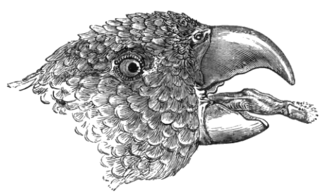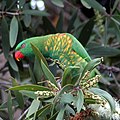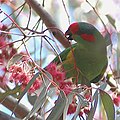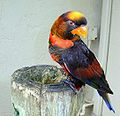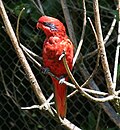Difference between revisions of "AY Honors/Parrots and Cockatoos/Answer Key"
m (1 revision from w:Lories and lorikeets) |
|||
| Line 1: | Line 1: | ||
| − | {{ | + | {{redirect|Lory|other uses|Lory (disambiguation)}} |
| − | == | + | {{Taxobox |
| − | === | + | | name = Lories and lorikeets |
| − | + | | image= Rainbow Lorikeet (Trichoglossus haematodus) -Nelson Bay -NSW.jpg | |
| − | + | | image_caption = [[Rainbow Lorikeet]] at Nelson Bay, NSW, Australia. | |
| − | + | | image_width = 240px | |
| − | + | | regnum = [[Animal]]ia | |
| + | | phylum = [[Chordate|Chordata]] | ||
| + | | classis = [[Bird|Aves]] | ||
| + | | ordo = [[Psittaciformes]] | ||
| + | | familia = [[true parrots|Psittacidae]] | ||
| + | | subfamilia = '''Loriinae''' | ||
| + | | subfamilia_authority = [[Prideaux John Selby|Selby]], 1836 | ||
| + | | subdivision_ranks = Genera | ||
| + | | subdivision = | ||
| + | ''[[Chalcopsitta]]''<br> | ||
| + | ''[[Eos (genus)|Eos]]''<br> | ||
| + | ''[[Pseudeos]]''<br> | ||
| + | ''[[Trichoglossus]]''<br> | ||
| + | ''[[Lorius]]''<br> | ||
| + | ''[[Phigys]]''<br> | ||
| + | ''[[Vini]]''<br> | ||
| + | ''[[Glossopsitta]]''<br> | ||
| + | ''[[Charmosyna]]''<br> | ||
| + | ''[[Oreopsittacus]]''<br> | ||
| + | ''[[Neopsittacus]]'' | ||
| + | }} | ||
| − | + | '''Lories''' and '''lorikeets''' are small to medium-sized arboreal [[parrot]]s which comprise the subfamily '''Loriinae'''. They are widely distributed throughout the [[Australasian]] region, including south-eastern [[Asia]], [[Polynesia]], [[Papua New Guinea]] and [[Australia]], and the majority have very brightly colored plumage. | |
| − | |||
| − | |||
| − | Image: | + | ==Morphology== |
| − | + | [[Image:LoryTongueLyd4.png|thumb|left|Tongue of a Lory]] | |
| − | + | Lories and lorikeets have specialized brush-tipped tongues for feeding on nectar and soft fruits. They can feed from the flowers of about 5,000 species of plants and use their specialised tongues to take the nectar. The tip of their tongues have tufts of papillae (extremely fine hairs), which collect nectar and pollen. | |
| − | + | Lorikeets have tapered wings and pointed tails that allow them to fly easily and display great agility.{{Fact|date=July 2007}} They also have strong feet and legs. They tend to be hyperactive and clownish in personality both in captivity and the wild.{{Fact|date=October 2007}} | |
| − | |||
| − | |||
| − | + | ==Classification== | |
| − | + | Lories and lorikeets are usually classified as the subfamily, '''Loriinae''', the most clearly distinct of the several rather uncertain subfamilies within the [[true parrots]] (Psittacidae) family. Some authorities regard the differences between the Loriinae and the other parrots as sufficient to justify giving the group full [[Family (biology)|family]] status, in which case, following the biological naming conventions, they become the '''Loriidae''', and are placed alongside the remaining true parrots (Psittacidae) and the [[cockatoo]]s (Cacatuidae) within the [[parrot]]s (Psittaciformes) [[Order (biology)|order]]. | |
| − | |||
| − | + | ==Nomenclature== | |
| + | The usage of the terms "lory" and "lorikeet" is subjective, like the usage of "parrot" and "parakeet". Species with longer tapering tails are generally referred to as "lorikeets", while species with short blunt tails are generally referred to as "lories".<ref>{{cite book | ||
| + | | last = Low | first = Rosemary | ||
| + | | title = Hancock House Encyclopedia of the Lories | ||
| + | | publisher = [[Hancock House]] | ||
| + | | date = 1998 | pages = pp. 85-87 | isbn = 0-88839-413-6 }}</ref> | ||
| − | + | ==Conservation== | |
| − | + | The [[Ultramarine Lorikeet]] is endangered. It is now one of the 50 rarest birds in the world. The [[Blue Lorikeet]] is classified as vulnerable. The introduction of European rats to the small island habitats of these birds is a major cause of their endangerment.<ref>Steadman D, (2006). ''Extinction and Biogeography in Tropical Pacific Birds'', University of Chicago Press. ISBN 978-0-226-77142-7</ref> Various conservation efforts have been made to relocate some of these birds to locations free of predation and habitat destruction. | |
| − | |||
| − | |||
| − | |||
| − | < | ||
| − | |||
| − | |||
| − | |||
| − | |||
| − | |||
| − | |||
| − | |||
| − | |||
| − | |||
| + | ==Colors== | ||
| + | The multi-colored [[Rainbow Lorikeet]] was one of the species of parrots appearing in the first edition of ''The Parrots of the World'' and also in [[John Gould]]'s lithographs of the Birds of Australia. Then and now, lories and lorikeets are described as one of the most beautiful species of parrot. | ||
| + | <gallery> | ||
| + | Image:BlackWingedLorikeet.jpg|[[Black-winged Lory]] | ||
| + | Image:RainbowLorikeetOregonZoo.jpg|Green-naped Lorikeet (subspecies of [[Rainbow Lorikeet]]) | ||
| + | Image:Scalybreastedlorikeet.jpg|[[Scaly-breasted Lorikeet]] | ||
| + | Image:PerfectLorikeetHead.jpg|[[Olive-headed Lorikeet]] | ||
| + | Image:Chalcopsitta sintillata - Yellow-streaked Lory at Fuengirola Zoo.jpg|[[Yellow-streaked Lory]] | ||
| + | Image:Musklorikeet.jpg|[[Musk Lorikeet]] | ||
| + | Image:Louisa - Dusky Lory.JPG|[[Dusky Lory]] | ||
| + | Image:BlueStreakedLory.jpg|[[Blue-streaked Lory]] | ||
</gallery> | </gallery> | ||
| − | == | + | ==Species and genus list== |
| − | === | + | Classification of parrots in the subfamily, Loriinae: |
| − | [[ | + | * Genus ''[[Chalcopsitta]]'' |
| − | + | ** [[Black Lory]], ''Chalcopsitta atra'' | |
| + | ** [[Brown Lory]], ''Chalcopsitta duivenbodei'' (also called Duyvenbode's Lory) | ||
| + | ** [[Yellow-streaked Lory]], ''Chalcopsitta sintillata'' | ||
| + | ** [[Cardinal Lory]], ''Chalcopsitta cardinalis'' | ||
| + | * Genus ''[[Eos (genus)|Eos]]'' | ||
| + | ** [[Black-winged Lory]], ''Eos cyanogenia'' | ||
| + | ** [[Violet-necked Lory]], ''Eos squamata'' | ||
| + | ** [[Blue-streaked Lory]], ''Eos reticulata'' | ||
| + | ** [[Red and Blue Lory]], ''Eos histrio'' | ||
| + | ** [[Red Lory]], ''Eos bornea'' | ||
| + | ** [[Blue-eared Lory]], ''Eos semilarvata'' | ||
| + | * Genus ''Pseudeos'' | ||
| + | ** [[Dusky Lory]], ''Pseudeos fuscata'' | ||
| + | * Genus ''[[Trichoglossus]]'' | ||
| + | ** [[Ornate Lorikeet]], ''Trichoglossus ornatus'' (also called Ornate Lory) | ||
| + | ** [[Pohnpei Lorikeet]], ''Trichoglossus rubiginosus'' (also called Ponape Lory) | ||
| + | ** [[Mindanao Lorikeet]], ''Trichoglossus johnstoniae'' (also called Johnstone's Lorikeet) | ||
| + | ** [[Yellow-and-green Lorikeet]], ''Trichoglossus flavoviridis'' | ||
| + | ** [[Rainbow Lorikeet]], ''Trichoglossus haematodus'' (many subspecies, some of which are sometimes classified as a species) | ||
| + | ** [[Scaly-breasted Lorikeet]], ''Trichoglossus chlorolepidotus'' | ||
| + | ** [[Olive-headed Lorikeet]], ''Trichoglossus euteles'' (also called Perfect Lorikeet) | ||
| + | * Genus ''[[Psitteuteles]]'' (sometimes classified in the Genus ''Trichoglossus'') | ||
| + | ** [[Varied Lorikeet]], ''Trichoglossus versicolor'' | ||
| + | ** [[Iris Lorikeet]], ''Trichoglossus iris'' | ||
| + | ** [[Goldie's Lorikeet]], ''Trichoglossus goldiei'' | ||
| + | * Genus ''[[Lorius]]'' | ||
| + | ** [[Purple-bellied Lory]], ''Lorius hypoinochrous'' | ||
| + | ** [[Black-capped Lory]], ''Lorius lory'' (synonym Stresemann's Lory, ''Lorius amabilis''[http://www.unep-wcmc.org/isdb/Taxonomy/tax-species-result.cfm?Genus=Lorius&species=amabilis&source=animals]) | ||
| + | ** [[White-naped Lory]], ''Lorius albidinuchus'' | ||
| + | ** [[Yellow-bibbed Lory]], ''Lorius chlorocercus'' | ||
| + | ** [[Purple-naped Lory]], ''Lorius domicellus'' (synonym Blue-thighed Lory, ''Lorius tibialis''[http://www.unep-wcmc.org/isdb/Taxonomy/tax-species-result.cfm?Genus=Lorius&species=tibialis&source=animals]) | ||
| + | ** [[Chattering Lory]], ''Lorius garrulus'' | ||
| + | * Genus ''Phigys'' | ||
| + | ** [[Collared Lory]], ''Phigys solitarius'' | ||
| + | * Genus ''[[Vini]]'' | ||
| + | ** [[Blue-crowned Lory]], ''Vini australis'' | ||
| + | ** [[Rimatara Lorikeet]], ''Vini kuhlii'' (also called Kuhl's Lorikeet) | ||
| + | ** [[Henderson Lorikeet]], ''Vini stepheni'' (also called Stephen's Lory) | ||
| + | ** [[Blue Lorikeet]], ''Vini peruviana'' (also called Tahitian Lory) | ||
| + | ** [[Ultramarine Lorikeet]], ''Vini ultramarina'' (also called Ultramarine Lory) | ||
| + | * Genus ''[[Glossopsitta]]'' | ||
| + | ** [[Musk Lorikeet]], ''Glossopsitta concinna'' | ||
| + | ** [[Little Lorikeet]], ''Glossopsitta pusilla'' | ||
| + | ** [[Purple-crowned Lorikeet]], ''Glossopsitta porphyrocephala'' | ||
| + | * Genus ''[[Charmosyna]]'' | ||
| + | ** [[Palm Lorikeet]], ''Charmosyna palmarum'' | ||
| + | ** [[Red-chinned Lorikeet]], ''Charmosyna rubrigularis'' | ||
| + | ** [[Meek's Lorikeet]], ''Charmosyna meeki'' | ||
| + | ** [[Blue-fronted Lorikeet]], ''Charmosyna toxopei'' | ||
| + | ** [[Striated Lorikeet]], ''Charmosyna multistriata'' | ||
| + | ** [[Pygmy Lorikeet]], ''Charmosyna wilhelminae'' (also called Wilhelmina's Lorikeet) | ||
| + | ** [[Red-fronted Lorikeet]], ''Charmosyna rubronotata'' (also called Red-spotted Lorikeet) | ||
| + | ** [[Red-flanked Lorikeet]], ''Charmosyna placentis'' | ||
| + | ** [[New Caledonian Lorikeet]], ''Charmosyna diadema'' (possibly extinct) | ||
| + | ** [[Red-throated Lorikeet]], ''Charmosyna amabilis'' | ||
| + | ** [[Duchess Lorikeet]], ''Charmosyna margarethae'' | ||
| + | ** [[Fairy Lorikeet]], ''Charmosyna pulchella'' | ||
| + | ** [[Josephine's Lorikeet]], ''Charmosyna josefinae'' (also called Josephine's Lory) | ||
| + | ** [[Papuan Lorikeet]], ''Charmosyna papou'' (also called Papuan Lory) | ||
| + | * Genus ''Oreopsittacus'' | ||
| + | ** [[Plum-faced Lorikeet]], ''Oreopsittacus arfaki'' (also called Whiskered Lorikeet) | ||
| + | * Genus ''[[Neopsittacus]]'' | ||
| + | ** [[Yellow-billed Lorikeet]], ''Neopsittacus musschenbroekii'' (also called Musschenbroek's Lorikeet) | ||
| + | ** [[Orange-billed Lorikeet]], ''Neopsittacus pullicauda'' (also called Emerald Lorikeet) | ||
| − | + | ==References== | |
| − | + | {{reflist}} | |
| − | |||
| − | |||
| − | |||
| − | |||
| − | |||
| − | |||
| − | |||
| − | |||
| − | |||
| − | |||
| − | |||
| − | |||
| − | |||
| − | |||
| − | |||
| − | |||
| − | {{ | ||
| − | |||
| − | |||
| − | |||
| − | |||
| − | |||
| − | |||
| − | |||
| − | + | ==External links== | |
| + | *ARKive - [http://www.arkive.org/species/GES/birds/Vini_peruviana/ images and movies of the blue lorikeet/tahitian lory ''(Vini peruviana)''] | ||
| − | + | {{commonscat|Loriinae}} | |
| − | |||
| − | |||
| − | |||
| − | {{ | ||
| − | + | [[Category:Loriinae|*]] | |
| − | [[ | + | [[Category:Subfamilies of birds]] |
| − | [[ | ||
| − | |||
| − | |||
| − | |||
| − | |||
| − | |||
| − | |||
| − | |||
| − | |||
| − | |||
| − | |||
| − | |||
| − | |||
| − | |||
| − | |||
| − | |||
| − | |||
| − | |||
| − | |||
| − | |||
| − | |||
| − | |||
| − | |||
| − | |||
| − | |||
| − | |||
| − | |||
| − | |||
| − | |||
| − | |||
| − | |||
| − | |||
| − | |||
| − | |||
| − | |||
| − | |||
| − | |||
| − | |||
| − | |||
| − | |||
| − | |||
| − | |||
| − | |||
| − | |||
| − | |||
| − | |||
| − | |||
| − | |||
| − | |||
| − | |||
| − | |||
| − | |||
| − | |||
| − | |||
| − | |||
| − | |||
| − | |||
| − | |||
| − | [[ | + | [[de:Lories]] |
| + | [[es:Loriinae]] | ||
| + | [[fr:Loriinae]] | ||
| + | [[it:Loriinae]] | ||
| + | [[he:לוריים]] | ||
| + | [[hu:Lórifélék]] | ||
| + | [[nl:Lori's (vogel)]] | ||
| + | [[ja:ヒインコ]] | ||
| + | [[no:Lorier (papegøyer)]] | ||
| + | [[pl:Lory]] | ||
| + | [[ru:Лориевые (попугаи)]] | ||
| + | [[sv:Loripapegojor]] | ||
Revision as of 00:51, 8 June 2008
Template:Redirect Template:Taxobox
Lories and lorikeets are small to medium-sized arboreal parrots which comprise the subfamily Loriinae. They are widely distributed throughout the Australasian region, including south-eastern Asia, Polynesia, Papua New Guinea and Australia, and the majority have very brightly colored plumage.
Morphology
Lories and lorikeets have specialized brush-tipped tongues for feeding on nectar and soft fruits. They can feed from the flowers of about 5,000 species of plants and use their specialised tongues to take the nectar. The tip of their tongues have tufts of papillae (extremely fine hairs), which collect nectar and pollen.
Lorikeets have tapered wings and pointed tails that allow them to fly easily and display great agility.Template:Fact They also have strong feet and legs. They tend to be hyperactive and clownish in personality both in captivity and the wild.Template:Fact
Classification
Lories and lorikeets are usually classified as the subfamily, Loriinae, the most clearly distinct of the several rather uncertain subfamilies within the true parrots (Psittacidae) family. Some authorities regard the differences between the Loriinae and the other parrots as sufficient to justify giving the group full family status, in which case, following the biological naming conventions, they become the Loriidae, and are placed alongside the remaining true parrots (Psittacidae) and the cockatoos (Cacatuidae) within the parrots (Psittaciformes) order.
Nomenclature
The usage of the terms "lory" and "lorikeet" is subjective, like the usage of "parrot" and "parakeet". Species with longer tapering tails are generally referred to as "lorikeets", while species with short blunt tails are generally referred to as "lories".&
Conservation
The Ultramarine Lorikeet is endangered. It is now one of the 50 rarest birds in the world. The Blue Lorikeet is classified as vulnerable. The introduction of European rats to the small island habitats of these birds is a major cause of their endangerment.& Various conservation efforts have been made to relocate some of these birds to locations free of predation and habitat destruction.
Colors
The multi-colored Rainbow Lorikeet was one of the species of parrots appearing in the first edition of The Parrots of the World and also in John Gould's lithographs of the Birds of Australia. Then and now, lories and lorikeets are described as one of the most beautiful species of parrot.
Green-naped Lorikeet (subspecies of Rainbow Lorikeet)
Species and genus list
Classification of parrots in the subfamily, Loriinae:
- Genus Chalcopsitta
- Black Lory, Chalcopsitta atra
- Brown Lory, Chalcopsitta duivenbodei (also called Duyvenbode's Lory)
- Yellow-streaked Lory, Chalcopsitta sintillata
- Cardinal Lory, Chalcopsitta cardinalis
- Genus Eos
- Black-winged Lory, Eos cyanogenia
- Violet-necked Lory, Eos squamata
- Blue-streaked Lory, Eos reticulata
- Red and Blue Lory, Eos histrio
- Red Lory, Eos bornea
- Blue-eared Lory, Eos semilarvata
- Genus Pseudeos
- Dusky Lory, Pseudeos fuscata
- Genus Trichoglossus
- Ornate Lorikeet, Trichoglossus ornatus (also called Ornate Lory)
- Pohnpei Lorikeet, Trichoglossus rubiginosus (also called Ponape Lory)
- Mindanao Lorikeet, Trichoglossus johnstoniae (also called Johnstone's Lorikeet)
- Yellow-and-green Lorikeet, Trichoglossus flavoviridis
- Rainbow Lorikeet, Trichoglossus haematodus (many subspecies, some of which are sometimes classified as a species)
- Scaly-breasted Lorikeet, Trichoglossus chlorolepidotus
- Olive-headed Lorikeet, Trichoglossus euteles (also called Perfect Lorikeet)
- Genus Psitteuteles (sometimes classified in the Genus Trichoglossus)
- Varied Lorikeet, Trichoglossus versicolor
- Iris Lorikeet, Trichoglossus iris
- Goldie's Lorikeet, Trichoglossus goldiei
- Genus Lorius
- Purple-bellied Lory, Lorius hypoinochrous
- Black-capped Lory, Lorius lory (synonym Stresemann's Lory, Lorius amabilis[1])
- White-naped Lory, Lorius albidinuchus
- Yellow-bibbed Lory, Lorius chlorocercus
- Purple-naped Lory, Lorius domicellus (synonym Blue-thighed Lory, Lorius tibialis[2])
- Chattering Lory, Lorius garrulus
- Genus Phigys
- Collared Lory, Phigys solitarius
- Genus Vini
- Blue-crowned Lory, Vini australis
- Rimatara Lorikeet, Vini kuhlii (also called Kuhl's Lorikeet)
- Henderson Lorikeet, Vini stepheni (also called Stephen's Lory)
- Blue Lorikeet, Vini peruviana (also called Tahitian Lory)
- Ultramarine Lorikeet, Vini ultramarina (also called Ultramarine Lory)
- Genus Glossopsitta
- Musk Lorikeet, Glossopsitta concinna
- Little Lorikeet, Glossopsitta pusilla
- Purple-crowned Lorikeet, Glossopsitta porphyrocephala
- Genus Charmosyna
- Palm Lorikeet, Charmosyna palmarum
- Red-chinned Lorikeet, Charmosyna rubrigularis
- Meek's Lorikeet, Charmosyna meeki
- Blue-fronted Lorikeet, Charmosyna toxopei
- Striated Lorikeet, Charmosyna multistriata
- Pygmy Lorikeet, Charmosyna wilhelminae (also called Wilhelmina's Lorikeet)
- Red-fronted Lorikeet, Charmosyna rubronotata (also called Red-spotted Lorikeet)
- Red-flanked Lorikeet, Charmosyna placentis
- New Caledonian Lorikeet, Charmosyna diadema (possibly extinct)
- Red-throated Lorikeet, Charmosyna amabilis
- Duchess Lorikeet, Charmosyna margarethae
- Fairy Lorikeet, Charmosyna pulchella
- Josephine's Lorikeet, Charmosyna josefinae (also called Josephine's Lory)
- Papuan Lorikeet, Charmosyna papou (also called Papuan Lory)
- Genus Oreopsittacus
- Plum-faced Lorikeet, Oreopsittacus arfaki (also called Whiskered Lorikeet)
- Genus Neopsittacus
- Yellow-billed Lorikeet, Neopsittacus musschenbroekii (also called Musschenbroek's Lorikeet)
- Orange-billed Lorikeet, Neopsittacus pullicauda (also called Emerald Lorikeet)
References
- ↑ Low, Rosemary (1998). Hancock House Encyclopedia of the Lories. Hancock House. pp. pp. 85-87. Template:Hide in printTemplate:Only in print.
- ↑ Steadman D, (2006). Extinction and Biogeography in Tropical Pacific Birds, University of Chicago Press. ISBN 978-0-226-77142-7
External links
de:Lories es:Loriinae fr:Loriinae it:Loriinae he:לוריים hu:Lórifélék nl:Lori's (vogel) ja:ヒインコ no:Lorier (papegøyer) pl:Lory ru:Лориевые (попугаи) sv:Loripapegojor
